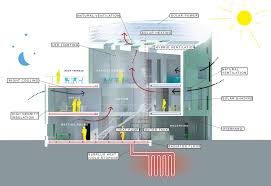The Importance of Sustainable Design Architecture
Sustainable design architecture is a growing trend in the field of architecture that focuses on creating buildings and structures that are environmentally responsible and resource-efficient throughout their lifecycle. This approach aims to minimize the negative impact on the environment while enhancing the health and well-being of occupants.
One of the key principles of sustainable design architecture is energy efficiency. By incorporating energy-efficient technologies and passive design strategies, architects can reduce the energy consumption of buildings, lower greenhouse gas emissions, and decrease reliance on non-renewable energy sources.
Another important aspect of sustainable design architecture is the use of sustainable materials. Architects are increasingly turning to eco-friendly materials such as recycled steel, bamboo, reclaimed wood, and low-VOC paints to reduce the environmental impact of construction projects.
Water conservation is also a crucial consideration in sustainable design architecture. By implementing water-saving fixtures, rainwater harvesting systems, and greywater recycling technologies, architects can help reduce water consumption and minimize strain on local water resources.
Furthermore, sustainable design architecture promotes biodiversity and green spaces within urban environments. Incorporating green roofs, vertical gardens, and communal green spaces not only enhances the aesthetic appeal of buildings but also provides habitat for wildlife, improves air quality, and promotes biodiversity in urban areas.
In conclusion, sustainable design architecture plays a vital role in addressing environmental challenges such as climate change, resource depletion, and pollution. By adopting sustainable practices in architectural design and construction, we can create buildings that are not only aesthetically pleasing but also environmentally friendly and socially responsible.
Sustainable Design Architecture: Understanding Principles, Practices, and Real-World Examples
- What is sustainability in architectural design?
- How do you create a sustainable architecture design?
- What is an example of sustainable design architecture?
- What are the four elements of sustainable design?
What is sustainability in architectural design?
Sustainability in architectural design refers to the practice of creating buildings and structures that minimize negative environmental impacts, conserve resources, and promote the well-being of occupants. It involves incorporating energy-efficient technologies, utilizing sustainable materials, optimizing water usage, and integrating green spaces to reduce the overall ecological footprint of a building. Sustainable architectural design aims to achieve a balance between environmental responsibility, social equity, and economic viability to ensure that buildings not only meet the needs of current generations but also preserve resources for future generations.
How do you create a sustainable architecture design?
Creating a sustainable architecture design involves a holistic approach that considers environmental, social, and economic factors. To create a sustainable architecture design, architects need to incorporate energy-efficient technologies, passive design strategies, and renewable energy sources to minimize the building’s energy consumption and carbon footprint. Additionally, using sustainable materials, such as recycled steel and reclaimed wood, can reduce the environmental impact of construction. Water conservation measures, like rainwater harvesting systems and efficient plumbing fixtures, are essential for minimizing water usage. Integrating green spaces, such as green roofs and vertical gardens, can enhance biodiversity and improve air quality. Collaboration with stakeholders and experts in sustainability is also crucial to ensure that the design meets environmental standards and contributes positively to the community.
What is an example of sustainable design architecture?
An excellent example of sustainable design architecture is the Bullitt Center in Seattle, Washington. This innovative building is often referred to as the greenest commercial building in the world. The Bullitt Center showcases a range of sustainable features, including a large rooftop solar array that generates more energy than the building consumes, rainwater harvesting systems for water conservation, natural ventilation for efficient cooling, and composting toilets to reduce water usage. Additionally, the Bullitt Center is constructed using locally sourced and environmentally friendly materials, making it a prime example of how sustainable design architecture can create buildings that are not only environmentally responsible but also energy-efficient and aesthetically appealing.
What are the four elements of sustainable design?
In sustainable design architecture, the four key elements are energy efficiency, use of sustainable materials, water conservation, and promotion of biodiversity. Energy efficiency focuses on reducing energy consumption and greenhouse gas emissions through the use of efficient technologies and design strategies. The use of sustainable materials involves choosing eco-friendly materials that have minimal environmental impact and promote resource conservation. Water conservation aims to minimize water consumption by implementing water-saving fixtures and technologies like rainwater harvesting. Lastly, promoting biodiversity involves incorporating green spaces and habitats within architectural designs to support wildlife, enhance air quality, and create a healthier environment for both humans and nature.

